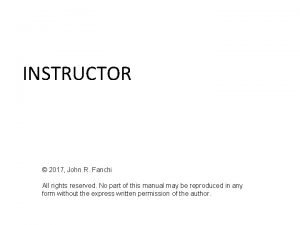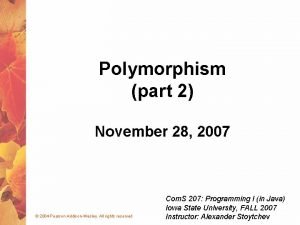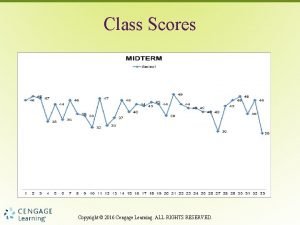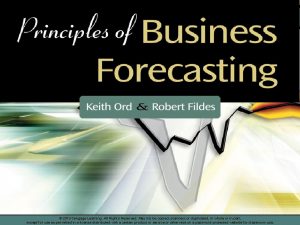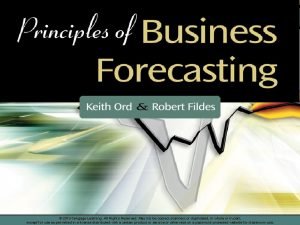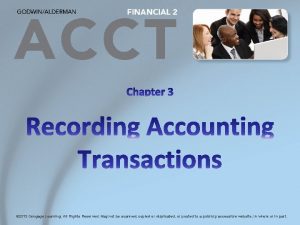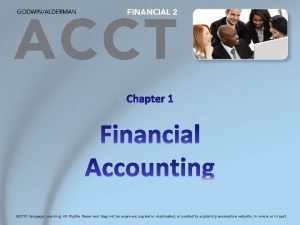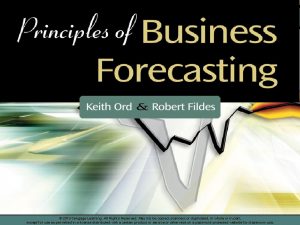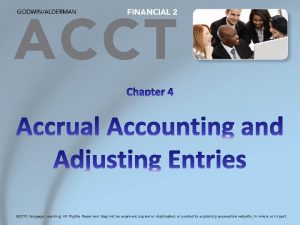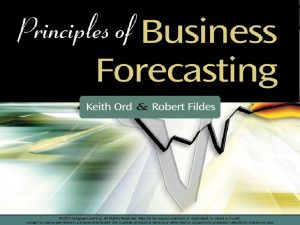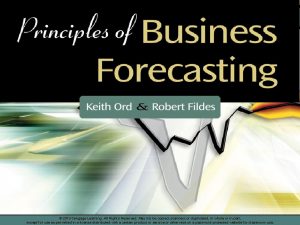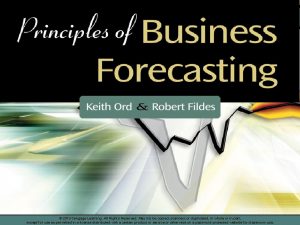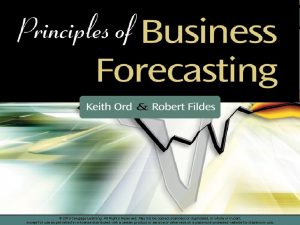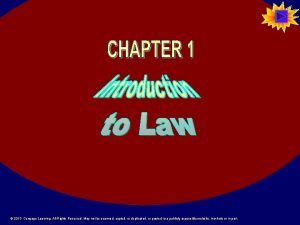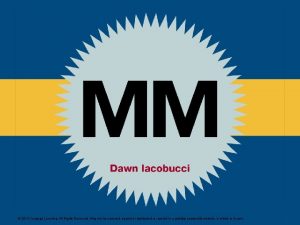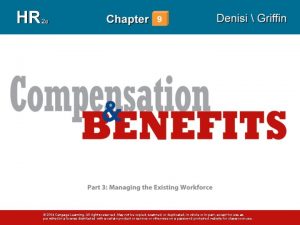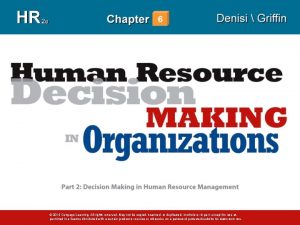2013 Cengage Learning All Rights Reserved May not























































- Slides: 55

© 2013 Cengage Learning. All Rights Reserved. May not be scanned, copied or duplicated, or posted to a publicly accessible website, in whole or in part.

Learning Objectives 1. Describe inventory and how it is recorded, expensed, and reported. 2. Calculate the cost of goods sold using different inventory costing methods. 3. Understand the income and tax effects of inventory cost flow assumptions. 4. Analyze the effects of inventory errors. 5. Demonstrate how inventory is estimated.

Learning Objectives 6. Apply the lower-of-cost-or-market rule to inventory. 7. Evaluate inventory through the calculation of horizontal, vertical, and ratio analyses. 8. Appendix: Record purchases and calculate the cost of goods sold under a periodic system.

LOI Recording, Expensing, and Reporting Inventory 1. Errors in inventory can affect income for multiple periods 2. How inventory can be estimated, if needed 3. How inventory must be adjusted if its market value falls below its cost

Inventory A tangible resource that is held for resale in the normal course of operations. The phrase “intended for resale” differentiates inventory from other operational assets. Inventory is recorded at its acquisition cost. • This includes all costs incurred to get the inventory: Delivered, or Prepared for resale

Examples of Costs Included in Inventory Purchase price Taxes paid Costs for shipping the product Insurance during transit Labor required to assemble the product Returns to and allowances from the vendor Purchase discounts from the vendor

Types of Inventory Systems Perpetual– Cost of Goods Sold is updated with each sale. Periodic- Cost of Goods Sold is recorded only at the end of a period.

Recording of Inventory Snowy Owl Outfitters purchases $20, 000 of inventory on account on October 10 and records the purchase as follows:

Transportation-In Suppose Snowy Owl pays a third-party carrier $300 to transport the inventory to its warehouse. Snowy Owl records the payment as follows:

Purchase Returns and Allowances On October 12, Snowy Owl is granted a $1, 000 reduction in the cost of the inventory due to blemishes on the merchandise. Snowy Owl records the reduction of the inventory cost and payable as follows:

Purchase Discount Snowy Owl pays its remaining $19, 000 bill to the vendor on October 15 and qualifies for a 1% early payment discount (or $19, 000 x 1% = $190), recorded as follows:

Summary of Net Purchases Given the preceding activity, Snowy Owl’s net purchases of inventory can be calculated as follows:

Expensing Inventory The account Cost of Goods Sold or Cost of Sales is used to capture the amount of inventory expensed during a period. On Nov. 2, if Snowy Owl sells inventory costing $400 for $600 cash, the following entries would be recorded.

Reporting Inventory and Cost of Goods Sold Wal-Mart: Inventory is by far this retailer’s largest current asset Target: Similarly, ($36 billion in 2010) inventory is this rival’s and cost of sales is its largest expense ($315 largest current asset ($7. 5 billion in 2010). and cost of sales is its largest expense ($45. 7 billion in 2010). Inventory is expected to be sold within a year and is reported on the balance sheet as a current asset. Because it is usually large, cost of goods sold is reported as a separate line on the income statement.

Example of Inventory and Cost of Goods Sold

LO 2 Inventory Costing Methods To determine the cost of inventory sold, companies can use one of the following methods: LIFO FIFO Specific Identification Moving Average

Illustration Assume that Nell Farms sells a specialty maple syrup that it purchases from Waverly Manufacturing. The following is Nell’s inventory activity for September. Net Income Sep. 1 Beginning inventory Sep. 4 Purchase Sep. 10 Sep. 15 Sep. 23 Sep. 30 Sale Purchase Sale Units Unit Cost 40 $12 Total $480 60 $13 $780 (65) 30 45 (50) $14 $15 $420 $675

Specific Identification Cost of Goods Sold Ending Inventory

First-in-First-Out (FIFO) Cost of Goods Sold Ending Inventory

Last-in-First-Out (LIFO) Cost of Goods Sold Ending Inventory

Moving Average Cost of Goods Sold Ending Inventory

Calculating Moving Average

LO 3 Comparing Inventory Costing Methods Because inventory costing methods affect both income statement and balance sheet accounts, a company must disclose the method that it uses. It must also use the same method consistently.

Relationships Summarized

LIFO and Tax Deferral Tax deferral is a temporary delay in the payment of income taxes. Tax deferrals are beneficial because a company can keep and use its cash for a longer period of time. While companies can use any of the four costing methods, some choose the LIFO method because of the resulting tax deferral.

LIFO Reserve LIFO reserve is the difference between the inventory reported on a LIFO basis and what inventory would be if reported on a FIFO basis. The reserve is cumulative and can be calculated by multiplying the reserve by the company’s tax rate. EXAMPLE (from Safeway’s 2010 financial footnotes): Inventories valued at FIFO: $1, 720 M Inventories valued at LIFO: $1, 685 M Difference: ($1, 720 - $1, 685 = $35 M). Assuming a tax rate of 30%, the taxes that Safeway has deferred as of the end of 2010 are $10. 5 M ($35 X 30%).

LO 4 Inventory Errors Inventory errors affect the following: • Through inventory • Through cost of goods sold

Inventory Errors If inventory is understated Current Period Next Period Inventory Understated Correct Cost of goods sold Overstated Net income Total assets If inventory is overstated Current Period Next Period Overstated Correct Understated Overstated Understated Correct Overstated Correct

LO 5 Estimating Ending Inventory A company must sometimes estimate its inventory balance. One example is when inventory is destroyed by a natural catastrophe. Another example is when a company prepares interim financial statements. The gross profit method of estimating inventory uses a company’s gross profit percentage to estimate cost of goods sold and then ending inventory.

Example 1 2 3

LO 6 Lower-of-Cost-or Market Requires inventory to be reported on the balance sheet at its market value if the market value is lower than the inventory’s cost. Is applied at the end of each accounting period by comparing inventory costs to market values.

Application of Lower-of-Cost-or-Market Inventories in total Major Groups of Inventories Individual Inventory Items

LCM Rule Cost < Market No Adjustment Market < Cost Adjust inventory down to the lower market value

LCM Example Dryden has four types of inventory (A, B, C, &D) in 2 groups. Cost and market values are computed for each inventory type, each inventory group, and total inventory. The three right columns show the value that should be reported for inventory when applying LCM to total inventories, to the two groups of inventory, and to each individual inventory item.

LCM Example No journal adjustment needed if Dryden uses the total inventories cost approach or the inventory group approach because LCM = Cost

LCM Example However, if Dryden applies LCM to individual inventory items, it will need to adjust its inventory by $120.

LO 7 Evaluating a Company’s Management of Inventory How well is Target managing its inventory?

Assessing Inventory Using Horizontal & Vertical Analysis

Target’s Analysis Horizontal analysis of inventory shows a $417 million, or 5. 8%, increase from 2009 to 2010 Vertical analysis indicates that inventories made up 16. 1% of Target’s total assets in 2009 and 17. 4% of total assets in 2010

Comparative Analysis Since a lower percentage means greater profits on sales, the comparison shows that Target outperformed Wal-Mart in 2010

Inventory Turnover Ratio This ratio compares the cost of goods sold during a period to the average inventory balance during that period and measures the ability to sell inventory. Target’s 2010 Inventory Turnover Ratio:

Days-in-Inventory Ratio This ratio converts the inventory turnover ratio into a measure of days by dividing the turnover ratio into 365 days. Target’s 2010 Days. In-Inventory Ratio:

Ethics and Appendix: Decision Making Periodic Inventory System In today’s business environment, companies have to be A periodic system does notofupdate the aware not onlyinventory of the economic impact their decisions, inventory but andalso costof oftheir goods sold accounts ethical impact. during the period. Instead, when purchases are made, they are recorded in a temporary account called Information Purchases and when sales are made, the resulting Good Ends? being usedis recorded, but not the cost. Bad Ends? revenue of goods for? sold. ed e c ex ment o T rn ? e v go mits? li To falsif y records ? ? ore To ign t produc ? ? safety

Recording of Inventory Snowy Owl purchases $20, 000 of inventory on account on October 10 and records the purchase as follows:

Transportation-In Suppose Snowy Owl pays a third-party carrier $300 to transport the inventory to its warehouse. Snowy Owl records the payment as follows:

Purchase Returns and Allowances On October 12, Snowy Owl is granted a $1, 000 reduction in the cost of the merchandise due to blemishes on the inventory. Snowy Owl records the reduction of the inventory cost and payable as follows:

Purchase Discount Snowy Owl pays its remaining $19, 000 bill to the vendor on October 15 and qualifies for a 1% early payment discount (or $19, 000 x 1% = $190), recorded as follows:

Summary of Net Purchases Given the preceding activity, Snowy Owl’s net purchases of inventory can be calculated as follows:

Illustration Assume that Nell Farms sells a specialty maple syrup that it purchases from Waverly Manufacturing. The following is Nell’s inventory purchases for September. Net Income Sep. 1 Beginning inventory Sep. 4 Purchase Sep. 15 Purchase Sep. 23 Purchase Units Unit Cost 40 $12 Total $480 60 $13 $780 30 45 $14 $15 $420 $675

Three Steps using Inventory Costing Methods Under a Periodic System Count the inventory on hand at the end of the period. 1 Use an inventory costing method to assign a cost to the ending inventory. 2 3 Calculate cost of goods sold using the cost of goods sold model.

Specific Identification: Periodic At the end of the month Nell counts 60 units on hand. 5 x $13 units 20 x $14 units 35 x $15 units

FIFO: Periodic At the end of the month Nell counts 60 units on hand.

LIFO: Periodic At the end of the month Nell counts 60 units on hand.

Weighted Average: Periodic At the end of the month Nell counts 60 units on hand. $13. 46 x 60 = $807. 60 (or approximately $808)

End of Chapter 7
 Cengage learning 2013
Cengage learning 2013 All rights reserved example
All rights reserved example Copyright 2015 all rights reserved
Copyright 2015 all rights reserved All rights reserved sentence
All rights reserved sentence Freesound content licence
Freesound content licence Confidential all rights reserved
Confidential all rights reserved Sentinel-controlled repetition
Sentinel-controlled repetition Copyright © 2015 all rights reserved
Copyright © 2015 all rights reserved 2012 pearson education inc
2012 pearson education inc Microsoft corporation. all rights reserved.
Microsoft corporation. all rights reserved. Microsoft corporation. all rights reserved
Microsoft corporation. all rights reserved Microsoft corporation. all rights reserved
Microsoft corporation. all rights reserved Pearson education inc. all rights reserved
Pearson education inc. all rights reserved Dell all rights reserved copyright 2009
Dell all rights reserved copyright 2009 Warning all rights reserved
Warning all rights reserved Siprop
Siprop All rights reserved formula
All rights reserved formula Warning all rights reserved
Warning all rights reserved Confidential all rights reserved
Confidential all rights reserved Microsoft corporation. all rights reserved
Microsoft corporation. all rights reserved Pearson education inc. all rights reserved
Pearson education inc. all rights reserved Copyright © 2018 all rights reserved
Copyright © 2018 all rights reserved 2017 all rights reserved
2017 all rights reserved Pearson education inc all rights reserved
Pearson education inc all rights reserved 2010 pearson education inc
2010 pearson education inc Confidential all rights reserved
Confidential all rights reserved Airbus deutschland gmbh
Airbus deutschland gmbh R rights reserved
R rights reserved Rights reserved
Rights reserved Hci patterns
Hci patterns Chapter 6:2 interpreting word parts
Chapter 6:2 interpreting word parts Cengage learning heart diagram
Cengage learning heart diagram Cengage learning heart diagram
Cengage learning heart diagram South-western cengage learning
South-western cengage learning Chapter 13 medical math assignment sheet cengage learning
Chapter 13 medical math assignment sheet cengage learning 2009 delmar cengage learning
2009 delmar cengage learning Cengage learning heart diagram
Cengage learning heart diagram Medical terminology chapter 1 learning exercises answers
Medical terminology chapter 1 learning exercises answers Cengage learning australia
Cengage learning australia Graphing tpr
Graphing tpr Cengage learning
Cengage learning Cengage learning
Cengage learning Wadsworth cengage learning
Wadsworth cengage learning Cengage learning
Cengage learning Cengage learning plant cell
Cengage learning plant cell Cengage learning
Cengage learning Cengage learning
Cengage learning Brooks cole cengage learning
Brooks cole cengage learning Chapter 7:10 respiratory system
Chapter 7:10 respiratory system 2014 cengage learning accounting answers
2014 cengage learning accounting answers Cengage chapter 7
Cengage chapter 7 Cengage learning
Cengage learning Cengage learning
Cengage learning Chapter 6 skeletal system
Chapter 6 skeletal system Cengage learning
Cengage learning 2009 delmar cengage learning
2009 delmar cengage learning



























